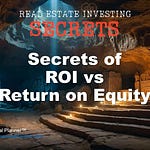In this module (16 of 46 in the Real Estate Investing Secrets course), you will learn:
What are the 4 primary areas of return on rental properties? And, what is the secondary return?
What time period do we typically look at for returns on rentals? How does that change from analyzing the deal to steady-state of owning the rental property?
What are the two types of appreciation? Is appreciation just inflation? How much might appreciation be on a typical rental property?
What is cash flow? What expenses does cash flow include in its calculation? How much cash flow might you see on a typical rental property? And, what can cause that number to vary… and by how much?
How do you think about paying down the loan on rental properties? How much might you be paying down on a typical rental property?
What about the tax benefits on rental properties? How much might you see in tax benefits from a typical rental property?
How do we account for needing reserves when buying rental properties? Do we earn returns on reserves? What might that look like on a typical rental property?
Looking at all the returns in terms of dollars for three distinct cases.
A special downloadable spreadsheet for tracking returns on all your rentals.
A deeper look into how good these returns are… and introducing a new way to measure returns to compare them to other investments.
What gets included as part of “investment” in return on investment calculations—including two unexpected components that most people miss? And, how do we deal with reserves?
Examples of what the return on investment might look like for three distinct cases on a typical rental property.
When looking at the return on investment from purchase through sale, what gets included as a cost of sale?
How do we calculate Net Sale Price, Profit From Sale Before Taxes, Capital Gains Taxes, Depreciation Recapture Taxes, and Profit After Taxes?
A look at annualized return on investment, compound return on investment and internal rate of return (IRR) for rental properties… and why you don’t need to calculate these yourself when using The World’s Greatest Real Estate Deal Analysis Spreadsheet™.
Why return on investment is perfect when analyzing a property you’re considering buying and when looking at how an investment performed between when you bought it and when you sold it… but why we use something completely different for properties we currently own.
Plus, much, much more…
Secrets of Return on Investment
Here are the slides from the presentation for your convenience…
Listen to this episode with a 7-day free trial
Subscribe to Real Estate Financial Planner™ to listen to this post and get 7 days of free access to the full post archives.












